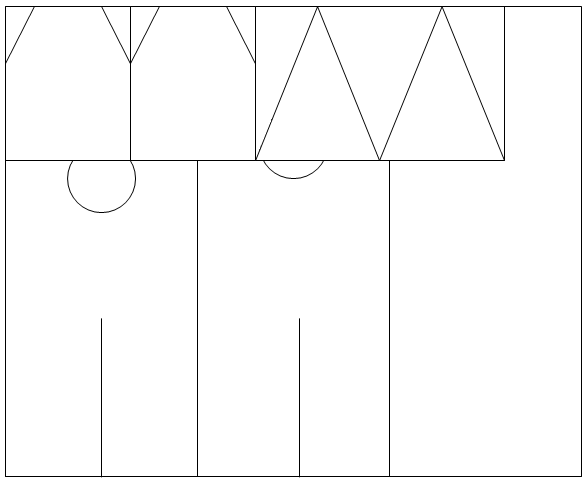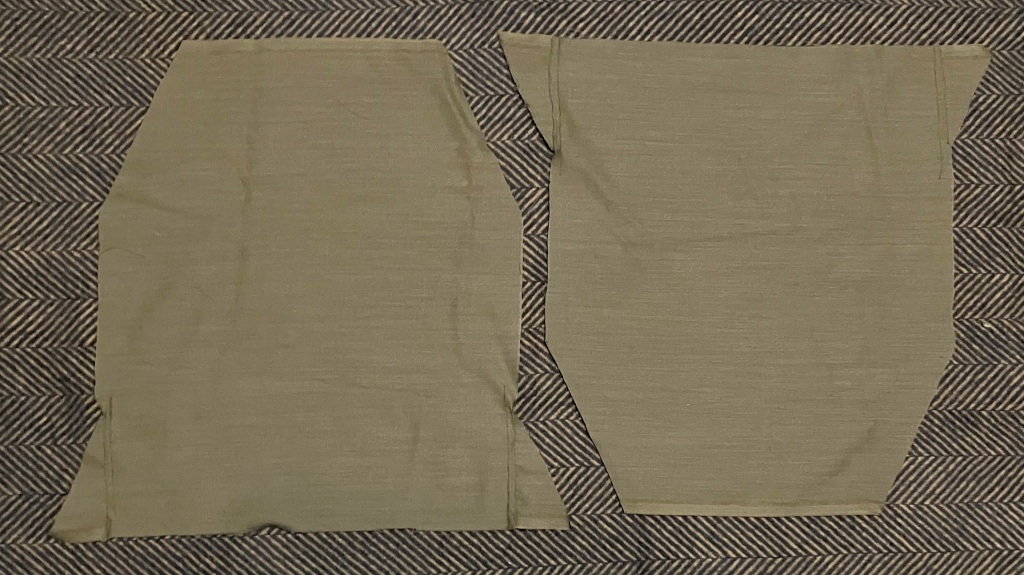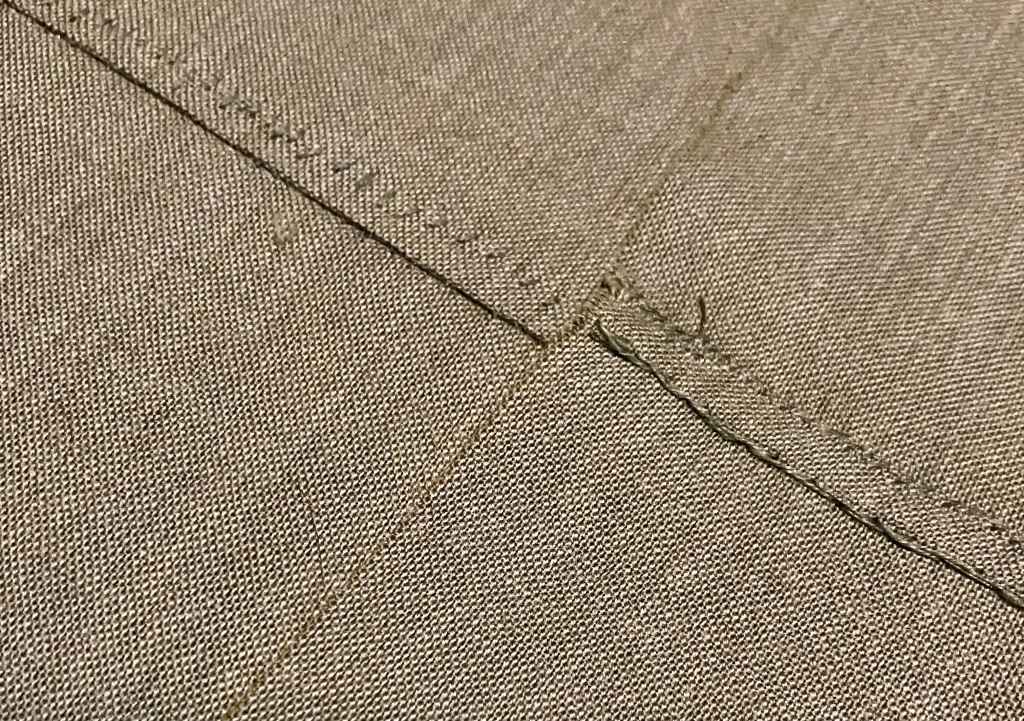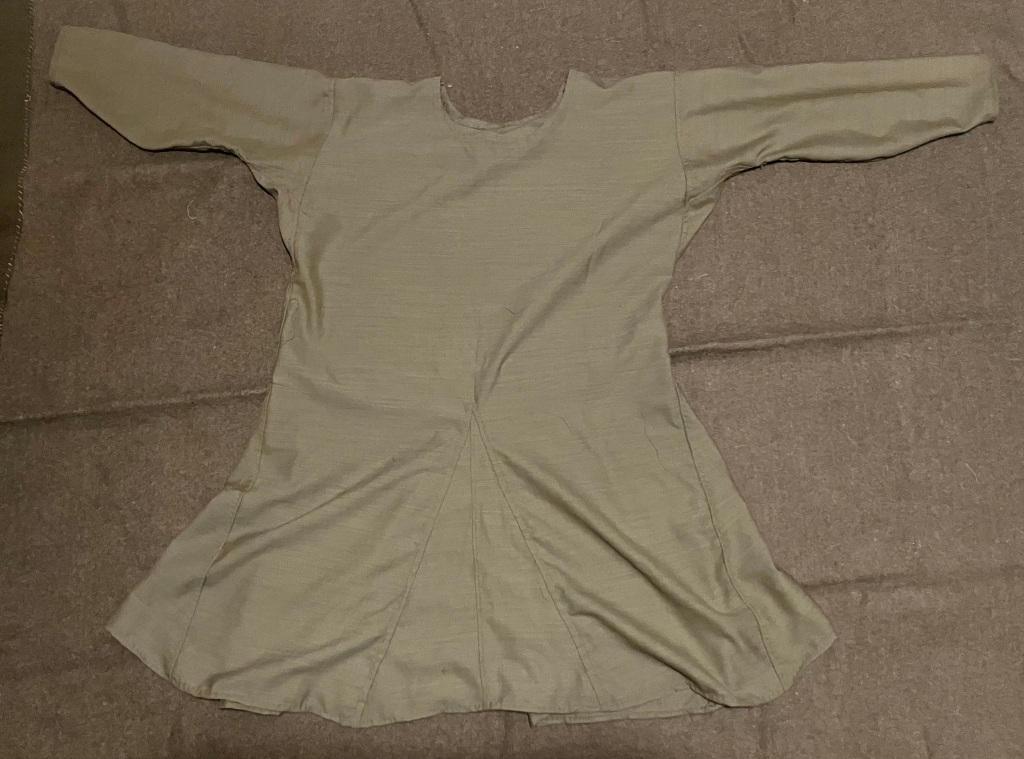This tunic was made as part of my participation in the Atlantian Persona Development Challenge.
While I am pretty well set for cold-weather garb (or at least, what passes for cold weather in Virginia), I am less pleased with my moderate-to-warm weather kit. If I’m doing something active, I can strip down to my undertunic and braies (as those engaged in labor are sometimes depicted in the 13th1, 14th2, and 15th3 centuries) but that is not appropriate for all occasions! I have a few tunics made from dyed linen, but my understanding is that dyed linen was uncommon in mid-14th century England, and that wool would be more appropriate. I am not well read in fibers, though, so I could be wrong!

Given my desire to wear wool in the warm, humid mid-Atlantic region, I purchased a very lightweight worsted wool from Burnley & Trowbridge in an olive drab that I thought would look nice and blend reasonably well with a wooded environment. It seems likely that this is really more a lateral move in authenticity than an improvement, though, since I don’t know that a fine worsted wool like this is any more appropriate for my 14th century English forester persona than dyed linen! For the construction of the tunic, I referenced the extant wool tunic the Bocksten Man was found wearing. The Bocksten Man was found in Sweden, and his clothing dates to 1350-13704. My impression is English, so this is not a perfect reference, but as the Bocksten Man’s clothing is one of the only finds of it’s kind and seems to resemble clothing depicted in contemporary English manuscripts, I do not think it is too much of a stretch to think my persona might wear similarly constructed garments.

While I referenced the general construction of the extant tunic5, I adjusted the measurements to suit my body (I am shorter and… broader than the Bocksten Man was) and cut the front and back of the body of the tunic as two separate pieces. The front and back of Bocksten Man’s tunic were made from one 230 cm piece of cloth, without a shoulder seam5. Since I only purchased two yards of fabric, I was able to make a longer tunic from the yardage by including a shoulder seam. I made the triangular underarm gussets that add width to the top of the sleeve from the cloth cut away from the lower part of the sleeve that makes it more fitted around the wrist. I don’t know that this is how the original gussets were made, but it seemed like an efficient way to use the material.

I tend to over-engineer most of the pieces of kit that I make, and tunics are no exception. I am hand-sewing the seams with a linen thread (yes, dyed linen, but just a little bit!), first by backstitching the two pieces of cloth together, then making them something akin to a flat felled seam by trimming one seam allowance, then tucking the raw edge of the longer seam allowance around and under the shorter one and whipstitching it down. That is probably more than is needed, but I’m hoping it will keep the seams strong and the cut edges of the fabric from fraying.

As I assembled the tunic, I found that the upper sleeves were a bit too narrow; I’ll make the sleeve “rectangle” wider in future tunics. To compensate, I added a diamond-shaped underarm gore. This solved the width problem, but resulted in a lot of seams meeting under the arm, so I don’t recommend this approach for this style of sleeve!
To mimic the extant tunic, I assembled the front godet from the two right-triangular pieces and sewed a false seam down the middle of the back godet. To set these pieces into a slit the body of the tunic, I followed the excellent tutorial on La cotte simple; I’ve attempted this type of tailoring before, and these instructions resulted in the smoothest time of it I’ve ever had!

I’m not totally happy with the finished tunic, but it’s a wearable piece of garb and I learned a lot making it!
References
- c. 1240. The Crusader Bible. New York, The Morgan Library and Museum, MS M.638, fol. 18r. Accessed August 4th, 2022. https://www.themorgan.org/collection/crusader-bible/35
- c. 1325-1340. The Luttrell Psalter. London, British Library, Additional MS 42130, fol. 74v. Accessed August 4th, 2022. http://www.bl.uk/manuscripts/Viewer.aspx?ref=add_ms_42130_f074v
- Albucasis. First half of the 15th century. Observations sur la nature et les propriétés de divers produits alimentaires et hygiéniques, sur des phénomènes météorologiques, sur divers actes de la vie humaine, etc. Paris, Bibliothèque nationale de France, NAL 1673, fol. 91v. Accessed August 4th, 2022. https://gallica.bnf.fr/ark:/12148/btv1b105380445/f214.item
- “The Bocksten Man’s Unique Outfit.” The Bocksten Man Find. Hallands kulturhistoriska museum. Accessed August 4th, 2022. https://museumhalland.se/en/the-bocksten-man/the-bocksten-mans-outfit/
- Carlson, I. Marc. “Kyrtles/Cotes/Tunics/Gowns – The Bocksten Bog Man.” Some Clothing of the Middle Ages. The University of Tulsa, April 23, 2003. Access August 4th, 2022. https://web.archive.org/web/20210226053359/http://www.personal.utulsa.edu/~marc-carlson/cloth/bocktunc.html
